2019 MERCEDES-BENZ SLC lane assist
[x] Cancel search: lane assistPage 166 of 306
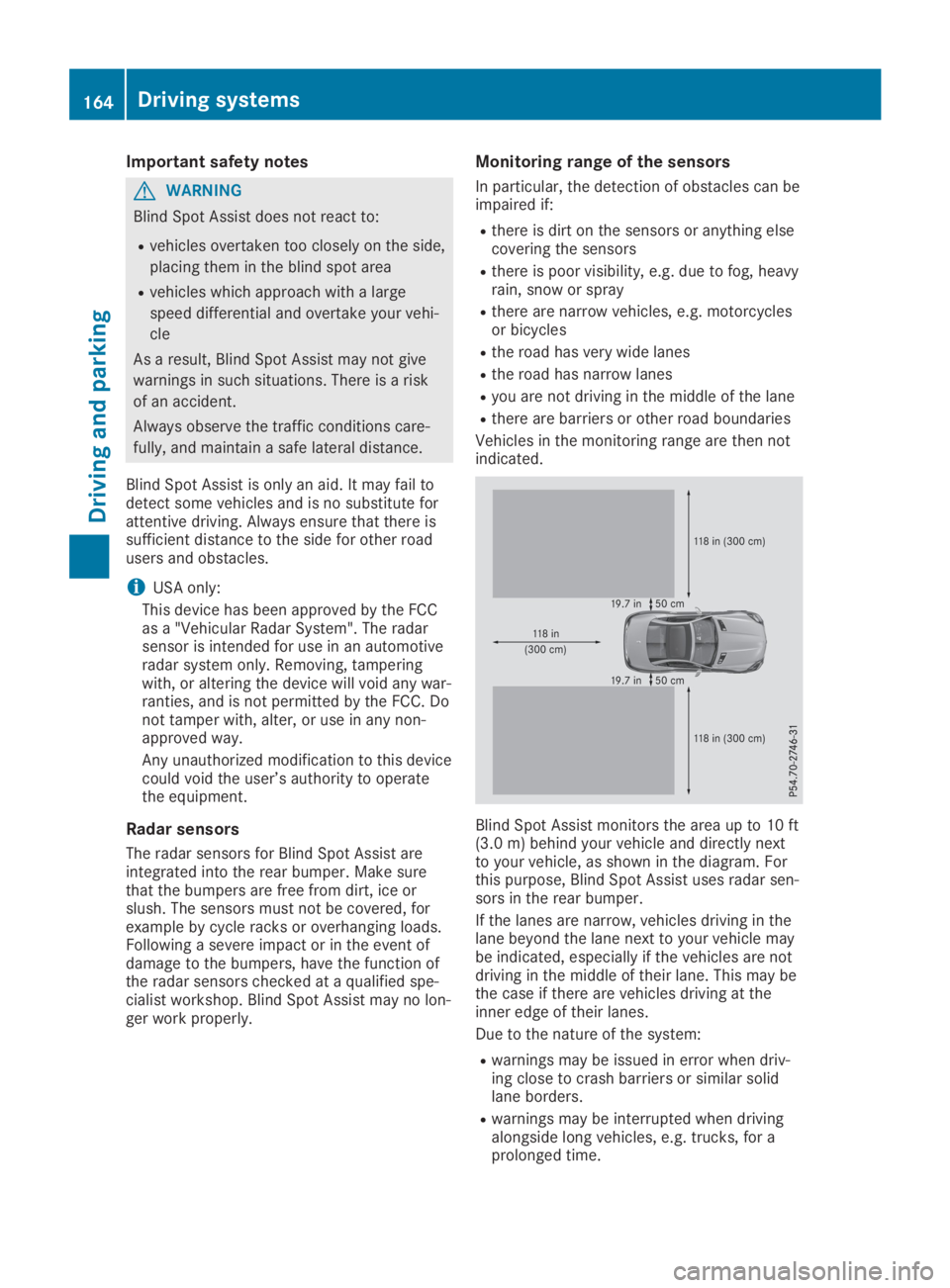
Important safety notes
GWARNING
Blind Spot Assist does not react to:
Rvehicles overtaken too closely on the side,
placing them in the blind spot area
Rvehicles which approach with a large
speed differential and overtake your vehi-
cle
As a result, Blind Spot Assist may not give
warnings in such situations. There is a risk
of an accident.
Always observe the traffic conditions care-
fully, and maintain a safe lateral distance.
Blind Spot Assist is only an aid. It may fail todetect some vehicles and is no substitute forattentive driving. Always ensure that there issufficient distance to the side for other roadusers and obstacles.
iUSA only:
This device has been approved by the FCCas a "Vehicular Radar System". The radarsensor is intended for use in an automotiveradar system only. Removing, tamperingwith, or altering the device will void any war-ranties, and is not permitted by the FCC. Donot tamper with, alter, or use in any non-approved way.
Any unauthorized modification to this devicecould void the user’s authority to operatethe equipment.
Radar sensors
The radar sensors for Blind Spot Assist areintegrated into the rear bumper. Make surethat the bumpers are free from dirt, ice orslush. The sensors must not be covered, forexample by cycle racks or overhanging loads.Following a severe impact or in the event ofdamage to the bumpers, have the function ofthe radar sensors checked at a qualified spe-cialist workshop. Blind Spot Assist may no lon-ger work properly.
Monitoring range of the sensors
In particular, the detection of obstacles can beimpaired if:
Rthere is dirt on the sensors or anything elsecovering the sensors
Rthere is poor visibility, e.g. due to fog, heavyrain, snow or spray
Rthere are narrow vehicles, e.g. motorcyclesor bicycles
Rthe road has very wide lanes
Rthe road has narrow lanes
Ryou are not driving in the middle of the lane
Rthere are barriers or other road boundaries
Vehicles in the monitoring range are then notindicated.
Blind Spot Assist monitors the area up to 10 ft(3.0 m) behind your vehicle and directly nextto your vehicle, as shown in the diagram. Forthis purpose, Blind Spot Assist uses radar sen-sors in the rear bumper.
If the lanes are narrow, vehicles driving in thelane beyond the lane next to your vehicle maybe indicated, especially if the vehicles are notdriving in the middle of their lane. This may bethe case if there are vehicles driving at theinner edge of their lanes.
Due to the nature of the system:
Rwarnings may be issued in error when driv-ing close to crash barriers or similar solidlane borders.
Rwarnings may be interrupted when drivingalongside long vehicles, e.g. trucks, for aprolonged time.
164Driving systems
Driving and pa rking
Page 167 of 306
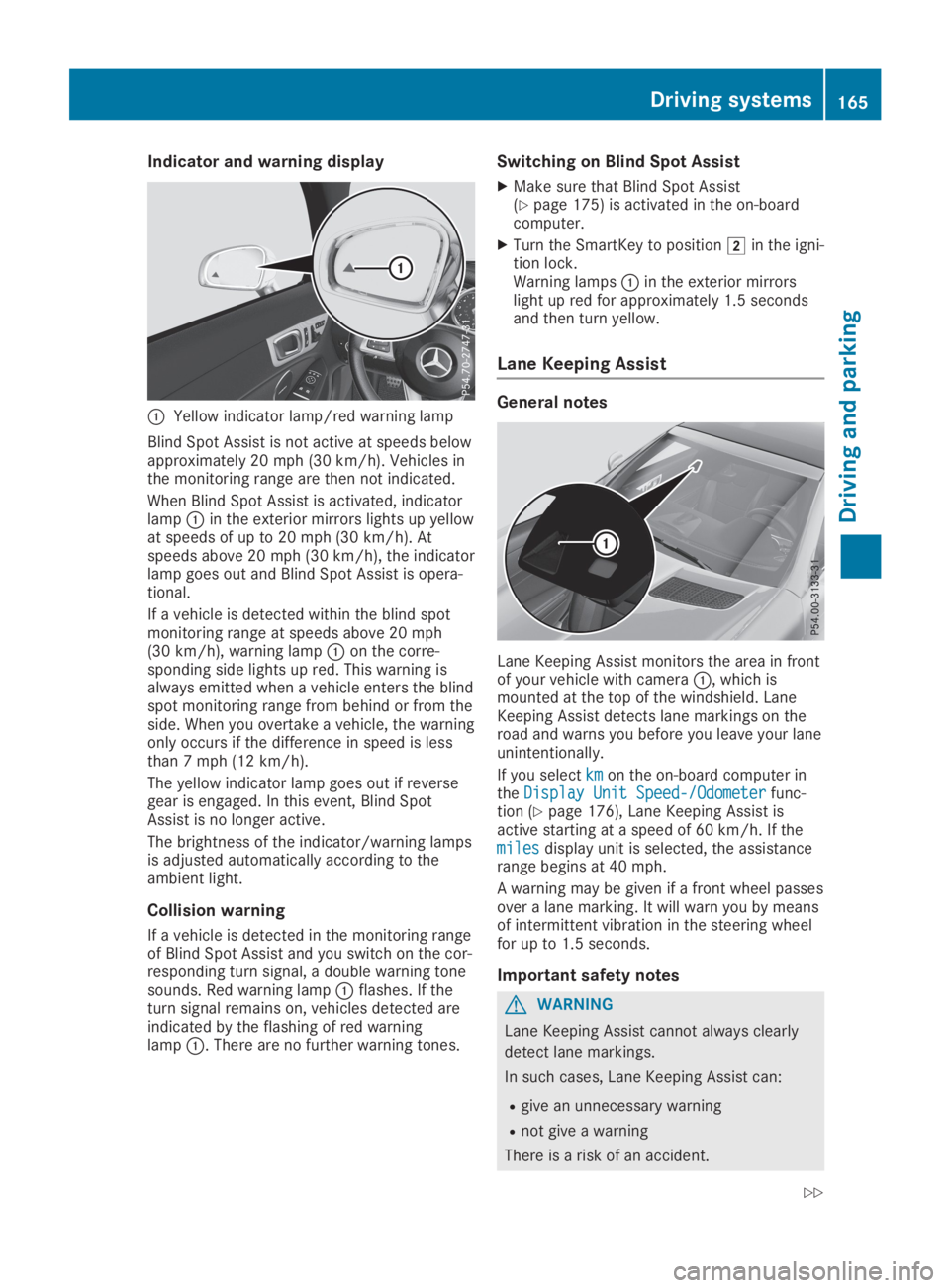
Indicator and warning display
�CYellow indicator lamp/red warning lamp
Blind Spot Assist is not active at speeds belowapproximately 20 mph (30 km/h). Vehicles inthe monitoring range are then not indicated.
When Blind Spot Assist is activated, indicatorlamp�Cin the exterior mirrors lights up yellowat speeds of up to 20 mph(30 km/h). Atspeeds above 20 mph (30 km/h), the indicatorlamp goes out and Blind Spot Assist is opera-tional.
If a vehicle is detected within the blind spotmonitoring range at speeds above 20 mph(30 km/h), warning lamp�Con the corre-sponding side lights up red. This warning isalways emitted when a vehicle enters the blindspot monitoring range from behind or from theside. When you overtake a vehicle, the warningonly occurs if the difference in speed is lessthan 7 mph (12 km/h).
The yellow indicator lamp goes out if reversegear is engaged. In this event, Blind SpotAssist is no longer active.
The brightness of the indicator/warning lampsis adjusted automatically according to theambient light.
Collision warning
If a vehicle is detected in the monitoring rangeof Blind Spot Assist and you switch on the cor-responding turn signal, a double warning tonesounds. Red warning lamp�Cflashes. If theturn signal remains on, vehicles detected areindicated by the flashing of red warninglamp�C. There are no further warning tones.
Switching on Blind Spot Assist
XMake sure that Blind Spot Assist(Ypage 175) is activated in the on-boardcomputer.
XTurn the SmartKey to position�Hin the igni-tion lock.Warning lamps�Cin the exterior mirrorslight up red for approximately 1.5 secondsand then turn yellow.
Lane Keeping Assist
General notes
Lane Keeping Assist monitors the area in frontof your vehicle with camera�C, which ismounted at the top of the windshield. LaneKeeping Assist detects lane markings on theroad and warns you before you leave your laneunintentionally.
If you selectkmkmon the on-board computer intheDisplay Unit Speed-/OdometerDisplay Unit Speed-/Odometerfunc-tion (Ypage 176), Lane Keeping Assist isactive starting at a speed of 60 km/h. If themilesmilesdisplay unit is selected, the assistancerange begins at 40 mph.
A warning may be given if a front wheel passesover a lane marking. It will warn you by meansof intermittent vibration in the steering wheelfor up to 1.5 seconds.
Important safety notes
GWARNING
Lane Keeping Assist cannot always clearly
detect lane markings.
In such cases, Lane Keeping Assist can:
Rgive an unnecessary warning
Rnot give a warning
There is a risk of an accident.
Driving systems165
Driving and parking
Z
Page 168 of 306

Always pay particular attention to the traffic
situation and keep within the lane, espe-
cially if Lane Keeping Assist alerts you.
GWARNING
The Lane Keeping Assist warning does not
return the vehicle to the original lane. There
is a risk of an accident.
You should always steer, brake or accelerate
yourself, in particular if warned by Lane
Keeping Assist.
If you fail to adapt your driving style, LaneKeeping Assist can neither reduce the risk ofan accident nor override the laws of physics.Lane Keeping Assist cannot take into accountthe road, traffic and weather conditions. LaneKeeping Assist is merely an aid. You areresponsible for the distance to the vehicle infront, for vehicle speed, for braking in goodtime and for staying in your lane.
The Lane Keeping Assist does not keep thevehicle in the lane.
The system may be impaired or may not func-tion if:
Rthere is poor visibility, e.g. due to insuffi-cient illumination of the road, or due tosnow, rain, fog or spray
Rthere is glare, e.g. from oncoming traffic,the sun or reflections (e.g. when the roadsurface is wet)
Rthe windshield is dirty, fogged up, damagedor covered, for instance by a sticker, in thevicinity of the camera
Rthere are no, several or unclear lane mark-ings for a lane, e.g. in areas with road con-struction work
Rthe lane markings are worn away, dark orcovered up, e.g. by dirt or snow
Rthe distance to the vehicle in front is toosmall and the lane markings thus cannot bedetected
Rthe lane markings change quickly, e.g. lanesbranch off, cross one another or merge
Rthe road is narrow and winding
Rthere are strong shadows cast on the road
Switching on Lane Keeping Assist
XSwitch on Lane Keeping Assist using the on-board computer; to do so, selectStandardStandardorAdaptiveAdaptive(Ypage 175).If you drive at speeds above 40 mph(60 km/h) and lane markings are detected,the lines in the assistance graphics display(Ypage 175) are shown in green. LaneKeeping Assist is ready for use.
Standard
IfStandardStandardis selected, no warning vibrationoccurs if:
Ryou switch on the turn signals. In this event,the warnings are suppressed for a certainperiod of time
Ra driving safety system intervenes, such as
ABS, BAS or ESP®
Adaptive
WhenAdaptiveAdaptiveis selected, no warning vibra-tion occurs if:
Ryou switch on the turn signals. In this event,the warnings are suppressed for a certainperiod of time
Ra driving safety system intervenes, e.g. ABS,
BAS or ESP®
Ryou accelerate hard, e.g. kickdown
Ryou brake hard
Ryou steer actively, e.g. swerve to avoid anobstacle or change lanes quickly
Ryou cut the corner on a sharp bend
In order that you are warned only when neces-sary and in good time if you cross the lanemarking, the system recognizes certain condi-tions and warns you accordingly.
The warning vibration occurs earlier if:
Ryou approach the outer lane marking on abend
Rthe road has very wide lanes, e.g. a freeway
Rthe system recognizes solid lane markings
The warning vibration occurs later if:
Rthe road has narrow lanes
Ryou cut the corner on a bend
166Driving systems
Driving an d parking
Page 177 of 306
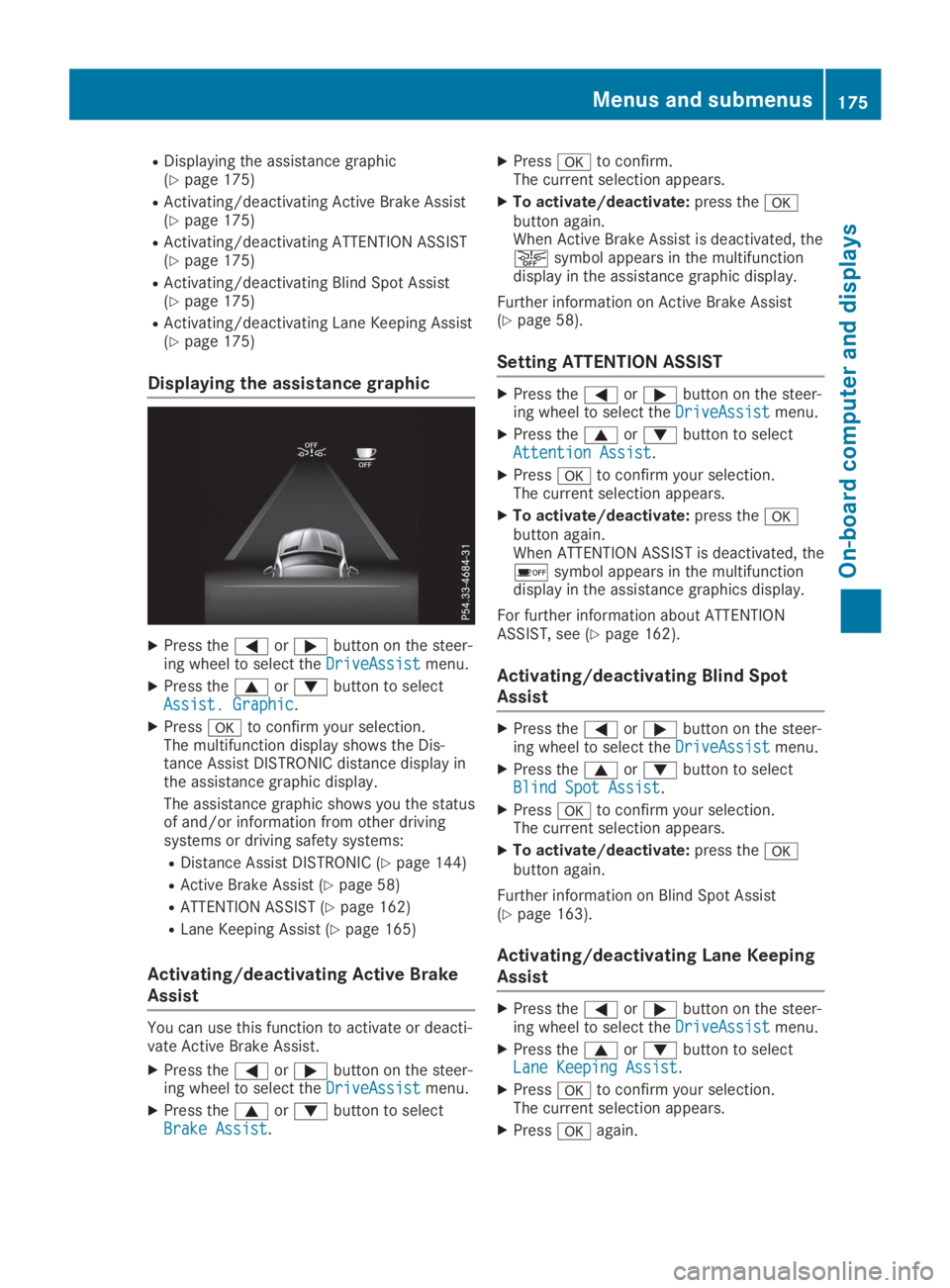
RDisplaying the assistance graphic(Ypage 175)
RActivating/deactivating Active Brake Assist(Ypage 175)
RActivating/deactivating ATTENTION ASSIST(Ypage 175)
RActivating/deactivating Blind Spot Assist(Ypage 175)
RActivating/deactivating Lane Keeping Assist(Ypage 175)
Displaying the assistance graphic
XPress the�Yor�ebutton on the steer-ing wheel to select theDriveAssistDriveAssistmenu.
XPress the�cor�dbutton to selectAssist. GraphicAssist. Graphic.
XPress�vto confirm your selection.The multifunction display shows the Dis-tance Assist DISTRONIC distance display inthe assistance graphic display.
The assistance graphic shows you the statusof and/or information from other drivingsystems or driving safety systems:
RDistance Assist DISTRONIC (Ypage 144)
RActive Brake Assist (Ypage 58)
RATTENTION ASSIST (Ypage 162)
RLane Keeping Assist (Ypage 165)
Activating/deactivating Active Brake
Assist
You can use this function to activate or deacti-vate Active Brake Assist.
XPress the�Yor�ebutton on the steer-ing wheel to select theDriveAssistDriveAssistmenu.
XPress the�cor�dbutton to selectBrake AssistBrake Assist.
XPress�vto confirm.The current selection appears.
XTo activate/deactivate:press the�vbutton again.When Active Brake Assist is deactivated, the�
Page 178 of 306
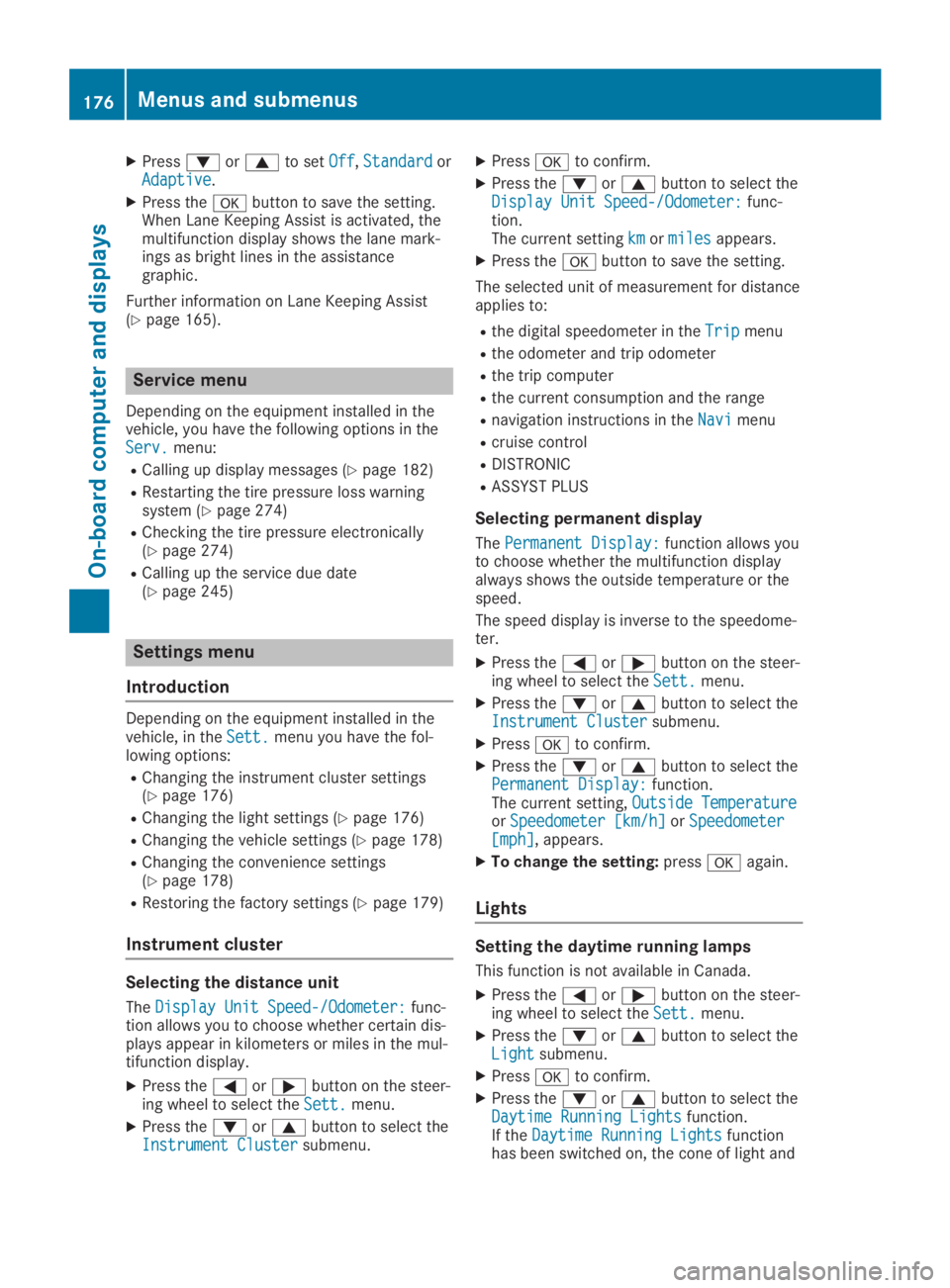
XPress�dor�cto setOffOff,StandardStandardorAdaptiveAdaptive.
XPress the�vbutton to save the setting.When Lane Keeping Assist is activated, themultifunction display shows the lane mark-ings as bright lines in the assistancegraphic.
Further information on Lane Keeping Assist(Ypage 165).
Service menu
Depending on the equipment installed in thevehicle, you have the following options in theServ.Serv.menu:
RCalling up display messages (Ypage 182)
RRestarting the tire pressure loss warningsystem (Ypage 274)
RChecking the tire pressure electronically(Ypage 274)
RCalling up the service due date(Ypage 245)
Settings menu
Introduction
Depending on the equipment installed in thevehicle, in theSett.Sett.menu you have the fol-lowing options:
RChanging the instrument cluster settings(Ypage 176)
RChanging the light settings (Ypage 176)
RChanging the vehicle settings (Ypage 178)
RChanging the convenience settings(Ypage 178)
RRestoring the factory settings (Ypage 179)
Instrument cluster
Selecting the distance unit
TheDisplay Unit Speed-/Odometer:Display Unit Speed-/Odometer:func-tion allows you to choose whether certain dis-plays appear in kilometers or miles in the mul-tifunction display.
XPress the�Yor�ebutton on the steer-ing wheel to select theSett.Sett.menu.
XPress the�dor�cbutton to select theInstrument ClusterInstrument Clustersubmenu.
XPress�vto confirm.
XPress the�dor�cbutton to select theDisplay Unit Speed-/Odometer:Display Unit Speed-/Odometer:func-tion.The current settingkmkmormilesmilesappears.
XPress the�vbutton to save the setting.
The selected unit of measurement for distanceapplies to:
Rthe digital speedometer in theTripTripmenu
Rthe odometer and trip odometer
Rthe trip computer
Rthe current consumption and the range
Rnavigation instructions in theNaviNavimenu
Rcruise control
RDISTRONIC
RASSYST PLUS
Selecting permanent display
ThePermanent Display:Permanent Display:function allows youto choose whether the multifunction displayalways shows the outside temperature or thespeed.
The speed display is inverse to the speedome-ter.
XPress the�Yor�ebutton on the steer-ing wheel to select theSett.Sett.menu.
XPress the�dor�cbutton to select theInstrument ClusterInstrument Clustersubmenu.
XPress�vto confirm.
XPress the�dor�cbutton to select thePermanent Display:Permanent Display:function.The current setting,Outside TemperatureOutside TemperatureorSpeedometer [km/h]Speedometer [km/h]orSpeedometerSpeedometer[mph][mph], appears.
XTo change the setting:press�vagain.
Lights
Setting the daytime running lamps
This function is not available in Canada.
XPress the�Yor�ebutton on the steer-ing wheel to select theSett.Sett.menu.
XPress the�dor�cbutton to select theLightLightsubmenu.
XPress�vto confirm.
XPress the�dor�cbutton to select theDaytime Running LightsDaytime Running Lightsfunction.If theDaytime Running LightsDaytime Running Lightsfunctionhas been switched on, the cone of light and
176Menus and submenus
On-board computer and displays
Page 200 of 306
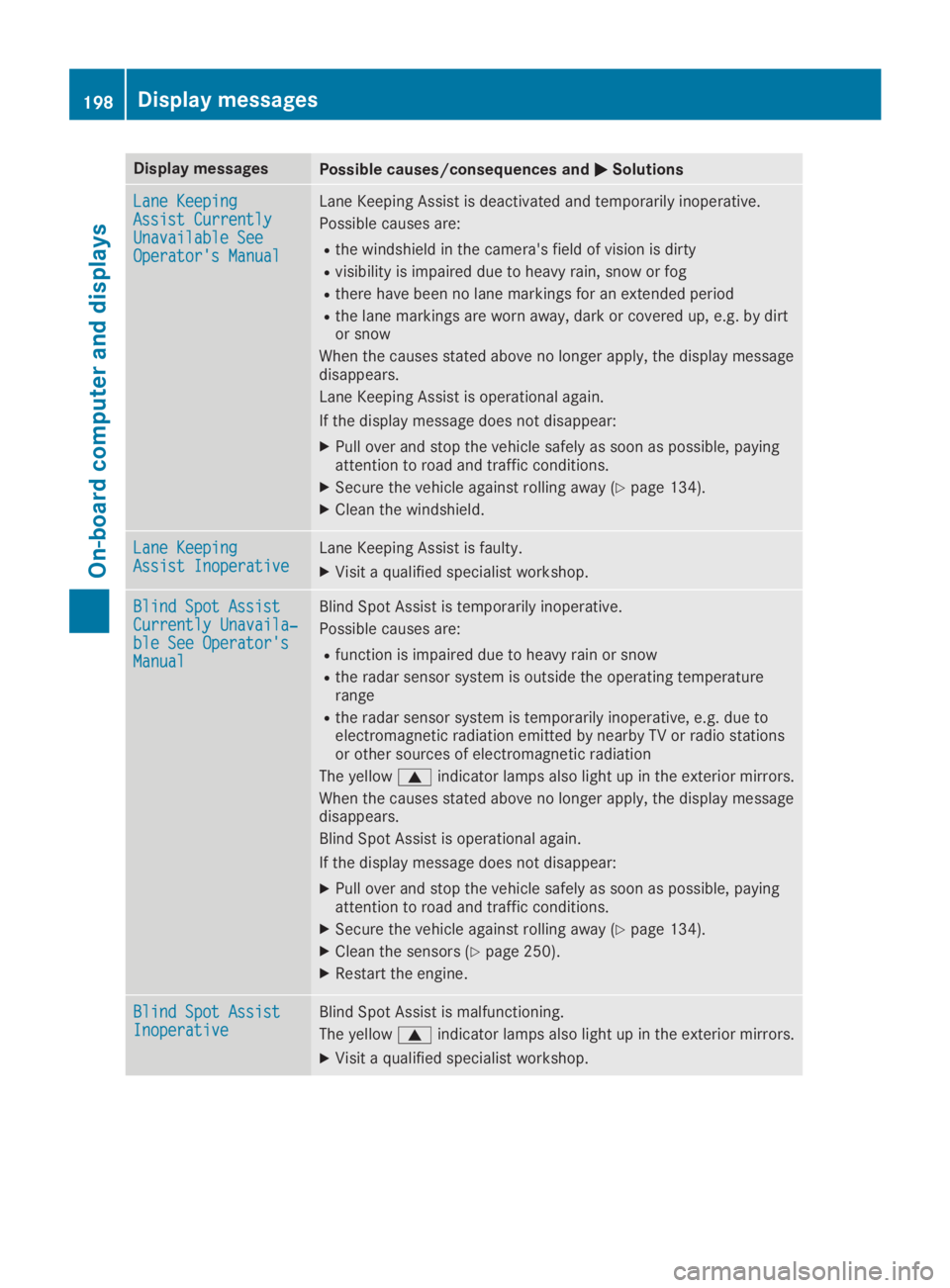
Display messagesPossible causes/consequences and�P�PSolutions
Lane KeepingLane KeepingAssist CurrentlyAssist CurrentlyUnavailable SeeUnavailable SeeOperator's ManualOperator's Manual
Lane Keeping Assist is deactivated and temporarily inoperative.
Possible causes are:
Rthe windshield in the camera's field of vision is dirty
Rvisibility is impaired due to heavy rain, snow or fog
Rthere have been no lane markings for an extended period
Rthe lane markings are worn away, dark or covered up, e.g. by dirtor snow
When the causes stated above no longer apply, the display messagedisappears.
Lane Keeping Assist is operational again.
If the display message does not disappear:
XPull over and stop the vehicle safely as soon as possible, payingattention to road and traffic conditions.
XSecure the vehicle against rolling away (Ypage 134).
XClean the windshield.
Lane KeepingLane KeepingAssist InoperativeAssist InoperativeLane Keeping Assist is faulty.
XVisit a qualified specialist workshop.
Blind Spot AssistBlind Spot AssistCurrently Unavaila‐Currently Unavaila‐ble See Operator'sble See Operator'sManualManual
Blind Spot Assist is temporarily inoperative.
Possible causes are:
Rfunction is impaired due to heavy rain or snow
Rthe radar sensor system is outside the operating temperaturerange
Rthe radar sensor system is temporarily inoperative, e.g. due toelectromagnetic radiation emitted by nearby TV or radio stationsor other sources of electromagnetic radiation
The yellow�cindicator lamps also light up in the exterior mirrors.
When the causes stated above no longer apply, the display messagedisappears.
Blind Spot Assist is operational again.
If the display message does not disappear:
XPull over and stop the vehicle safely as soon as possible, payingattention to road and traffic conditions.
XSecure the vehicle against rolling away (Ypage 134).
XClean the sensors (Ypage 250).
XRestart the engine.
Blind Spot AssistBlind Spot AssistInoperativeInoperativeBlind Spot Assist is malfunctioning.
The yellow�cindicator lamps also light up in the exterior mirrors.
XVisit a qualified specialist workshop.
198Displaymessages
On-b oard computer and displays